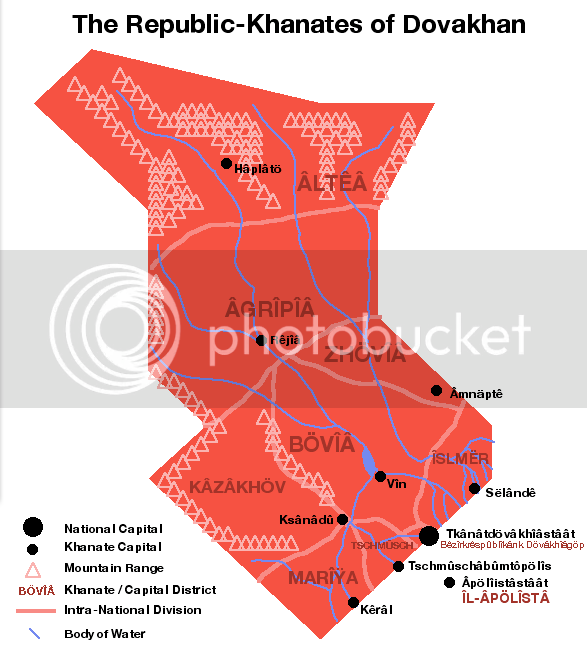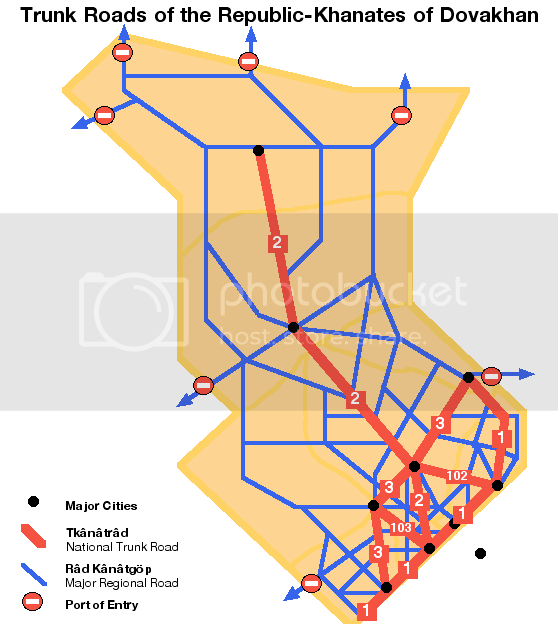See
REGIONS
Dovakhan is divided into 9 Geographically based khanates, 1 capital district, and 1 freely-associated state:
- Apolistia Island (Âpôlîstâstâât)
Apolistia Island khanate includes the large prefecture/commune of Âpölîstîâstâât (see MAJOR CITIES) on the main Apolista Island. However, it also includes the scarcely-inhabited, outlying islands of Nêbûkânêsrâ, Ântîbölîât, and Êfrûsârât which once acted as outposts of the empire.
The region has a Mediterranean microclimate that constrasts the dominantly Oceanic climate of the Dovakhanese coast.
- Mariya (Kêrâl)
Oceanic climates prevail in the khanate, situated on the windward side of the Khovian Mountains and home to the great Mârîÿ River. Before the integration of the free city of Selande (see MAJOR CITIES) into the Sun and Moon Empire, Mariya was the imperial shipping centre and still boasts a major secondary market for banking and marine industry.
The main city, Kêrâl, is a well-preserved Ancient Dovakhanese town with wood and stone structures that recall Dovakhan’s steppe origins.
- Tschmusch (Tschmuschboumtopolis)
This region, Dovakhan’s most populous and densely-populated, is basically Tschmuschaboumpolis and its satellite cities. Begun as the ancient capital of the unified Dovakhan, this region has always been the cultural and economic centre of the nation. It is not hard to get to this region, because the main airport, rail links, and roadways in the country are all here. For more info on Tschmuschaboumtopolis, see below (MAJOR CITIES).
Tschmusch is heavily industrialised, but intelligent planning has brought some relief in the form of copious urban green spaces and vast swaths of protected forest. However, make no mistake, this is Dovakhanese life at its most chaotic. The tangle of roadways and railways are certainly not for the faint of heart, but the cultural importance of this region outweighs all of its incoveniences.
- Zhov (Âmnäptê)
Located mostly in the marshy inland portion of the Northeastern Lowlands, Zhov has remained under-developed. The people that live there engage in limited mineral mining. The capital and main city of the khanate, Âmnäptê, is the centre of this trade and rather utilitarian in appearance with Soviet-style superquadras dominating the skyline.
The Western portion of Zhov, removed from the marshes, is dominated by pristine river valleys that serve as a buffer between the grain-growing khanate of Agrippia and the wine-growing khanate of Bövîâ.
- Agripia (Rêjïnâ)
The rolling plains of this khanate are known as the breadbasket of Dovakhan. The landscape is dotted with a mixture of traditional collective farms and newer industrial farms. In any case, the order of the day is… farming and historical sites are limited in this recently-settled khanate. The independent traveller is most likely to sojourn here only if volunteering on one of the famous collective farms (see WORK). Those lucky souls will enjoy breathtaking sunsets on the endless horizons of swaying grain.
Rêjïnâ, the capital, is located at the convergence of a river, a national high-speed rail line, and a major roadway. It is a small, but well-appointed new town of mid-rise Bauhaus dwellings and tree-lined boulevards. As to be expected, the labor market is dominated by agribusiness interests such as meat-packing and shipping. One of its more interesting sights is Granary City, a skyline of grain towers that emerges majestically out of the prairie.
- Kazakhov (Ksânâdû)
Almost completely surrounded by the leeward side of the Khovian Mountains, this region has a Mediterranean climate along the relatively narrow Kâzâk River Valley and a semiarid steppe in the vast interior.
The nomadic, horse-centred people that grew out of this land, the Khazakhov, would eventually unite under the MîöMïö the Great and conquer what would become modern Dovakhan.
Today, Kazakhov remains the least populous khanates in Southern Dovakhan. This fact however, along with the favourably dry climate, has made Kazakhov a viable secondary destination for high tech companies not wanting to set up shop in already-crowded Tschmusch bloc.
The largest city in this sparsely-populated khanate is Ksânâdû in the South-Central part of the region, near the boder with Mariya. It was traditionally a trading post for the Khazakhov tribal merchants, epitomized by the numerous bazaars and the Central Asian look-and-feel of the old city. However, attesting to the dual identity of the khanate is the new city of Ksânâdû, which is a sleek and modern and home to the high tech companies that operate major server farms and solar istallations in the city’s outskirts.
Ksânâdû is well-served by the high speed rail network and national highways, and thus the perfect staging ground for exciting treks across the interior. Thrice-daily regional trains bisect the interior north-to-sound and east-to-west, and contain full-service dining and equipment repair for the active tourist.
- Isslmeer (Sëlândê)
Lying in the vast Northeastern Lowlands, one eighth of Southern Dovakhan’s newest khanate was reclaimed from the sea. This, the most hard-won region in Dovakhan, is also its most diverse thanks to the major port city at Sëlândê (see MAJOR CITIES).
- Bovia (Vîn)
Before the Virgin Lands Program of the early twentieth century encouraged settlement in Agripia, Bovia was the breadbasket of Dovakhan. It’s rolling, verdant hills and valleys offer welcome respite to the chaos of the high-density conurbations to the South. Town dedicated to dairy, perfume, and other bucolic artisanry dot the region, with Vîn (see MAJOR CITIES) at its centre.
- Altea (Hâplâtö)
Altea is Dovakhan’s most nothern khanate with a boreal forest climate to match its location among the similarly-named Altean Mountains. This is a region of dramatic landscapes dominated by pioneering souls connected with the exploitation of the region’s vast natural resources. The capital of this frontier mania is Hâplâtö (see MAJOR CITIES).
Outside of the capital, Altea is a vast hinterland home to pockets of traditional boreal culture. Though largely domesticated in Dovakhanese-sponsored new towns, Altean culture is going strong as its resilient people adapt to impending civilization. These new towns are often near traditional Altean cultural sites and thus highly recommendable, but while hand-me-down trains service the area, an automobile is advised for navigating the forbidding terrain surrounding the major settlements.
- Republican District of Dovakhia (Tkânâtdövâkhîâstâât)
Comprised of the capital city and a generous green belt, the Republican District is an exemplar of Bauhaus architecture and sustainable urban planning. Wide, tree-lined boulevards cut across the strictly-grided city where a sort of mid-rise, Bauhaus-influenced Haussmannian block dominates the urban landscape.
For more info, see below (MAJOR CITIES).
- Tokana (Alv’a-On/Âzûr)
WARNING: Due to recent left-wing revolts to dissolve the free association pact and other forms of “Dovakhanese oppresssion,” Tokana is considered extremely volatile and dangerous. Native resentment towards the indigenous Dovakhanese population, the Marianks, may cause Eurasian tourists to be targeted. Airport Island in Alv’a-On/Azur is occupied by the Dovakhanese military, and all commercial flights there have been cancelled.
[s]This freely associated island state was once a colony of Dovakhan known as Dovakhanese Marian Sea. It is an archipelago of lush tropical islands and atolls inhabited by distant descendants of the Dannistrian people that left that island nation at the behest of their spiritual founder, Halv’o (Alv’a in Tokan). Accordingly, most tourists will come for the sun and fun of this bona fide Dovakhanese banana republic. The main natural resources of this island state are sugar, tropical fruits, and coffee, which is what makes it so important to the Dovakhanese.
The capital, Alv’a-On (Âzûr), is the biggest city and current national capital. Despite a recent effort at increasing the influence of Tokan culture, the city has a strong mestizo and cosmopolitan character that permeates in the people as well as the stucco, Kazakhov-influenced architecture. It’s a beautiful, Dovakhanese-style city with all the amenities of culture and amusement the independent traveller may desire.
The best form of transportation in the shallow Marian Sea waters is by catamaran, lateen sailboat (dönî), or even swimming if you find yourself the northern hinterland. On that note, get out of Âzûr and the tourist islands and sail north to where you can find some of the best preserved examples of traditional Dannistrian/Tokan lifestyle.[/s]
MAJOR CITIES
Âpölîstîâstâât: Founded in around 1500 BCE as the capital of Sun and Moon Empire, Apolistiana Island, located 30 miles off the mainland, has been the political heart of Dovakhan until quite recently (1919). Though it is now a sleepy (albeit still stunningly beautiful) provincial town, Apolistianastaat is an essential point of interest for any visitor to Dovakhan. Take in the unique architecture of the island and especially that of the ancient Old Town and Imperial Complex (called the Palace Museum) located atop a 30 metre plateau with a stunning waterfall known to locals as Mariyas Dressing Table spilling off it into a giant pool below. Also be sure to note the lack of cars, this is the largest car-free area in Dovakhan. If the enormity of the cultural natural, and perhaps spiritual significance of the place proves exhausting, be sure to check out the famous beaches that surround the island.
Tschmuschaboumtopolis: Some Dovakhanese will try and tell you that Tschmuschaboumtopolis is a city that has lost its soul, albeit mostly in jest. These claims are absolutely false. The economic capital of Dovakhan and its largest city is as rich, if not richer, in cultural value than it is in monetary capital. Must-sees are the Museum/Library (Ancient Palace), the Old Port, Feiro Fields Park, the Railway Station (the largest in the world), 19th July Square, and Revolution Park.
Selande is the newest of the three primate cities of Dovakhan. It was founded by three merchants, Ander Lelys, Jan Lars, and Hel Marais duringthe 14th century. They wanted to join forces to protect their three trading posts located at the marshy mouth of three rivers just outside of imperial territory against the Sun and Moon Empire’s attempt to impose taxes on the port area. The towns history as a free port made it an attractive destination for foreign merchants, notably French Jews during the 17-19th centuries and later for anti-monarchal intellectuals and artists. After the Revolution, the city became Dovakhans cultural (and ironically counter-cultural) capital. It is known as one of Dovakhans most relaxed, liberal, and charming cities. The red-light district along the railway, the Jewish/French Quarter, the politically-charged Little Leningrad, and the hippy area of New Canal are must-sees for any traveller.
Tkânâtdövâkhîastâât was founded in 1920 at the end of the Revolution as triplet cities to house the three branches of government. It is the Republican answer to Âpölîstîânâstâât and is indeed the closest city to the island. Now merged, it is chiefly a ceremonial capital with leafly boulevards and modernist architecture, though a new technology park is in development at the periphery. The newest developments are Mîömïö Plaza, which now houses all three branches of of government and the Esplanade of Khanates which houses the various executive departments. Its revolutionary and symbolic design make it truly the “City Beautiful” of Dovakhan. Convient access from Sëlândê and Tschmuschaboumtopolis by high speed train make this an essential visit for those in the South Coastal Metropolitan Area.
Vîn is the largest inland city in Dovakhan and the fourth largest overall. It is located at the confluence of three rivers into a picturesque lake. It all provides the perfect setting for the wine and perfume industry the are the reason for the city’s creation and the fuel for its growth. Beaux Arts buildings and English gardens dominate the landscape of this city, which is often described as “the biggest village in Dovakhan.” Essential sights are the various perfume and wine factories as well as a well-appointed Museum of Fine Art and Civic Theatre.
Hâplâtö is the northernmost major city in Dovakhan and boasts a healthy industry through mineral mining and IT research, but is also quite lovely as the town planners were intelligent enough to endow it with stunning vistas of surrounding mountains and close-by lake along with plenty of green space. This newly-developed region boasts modern architecture and a prevailing pioneer attitude amongst its classes of mineral barons, tech nerds, and miners.

